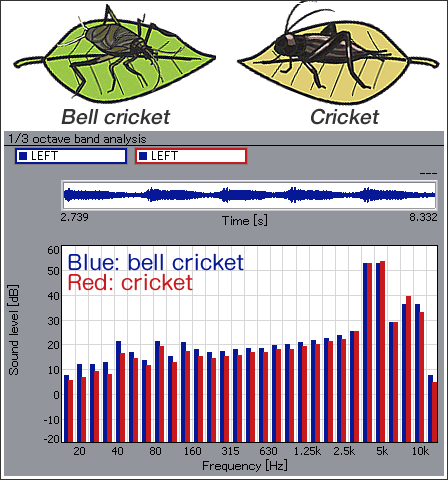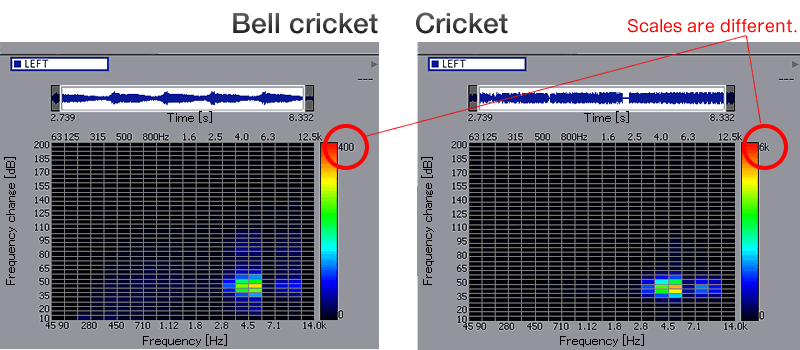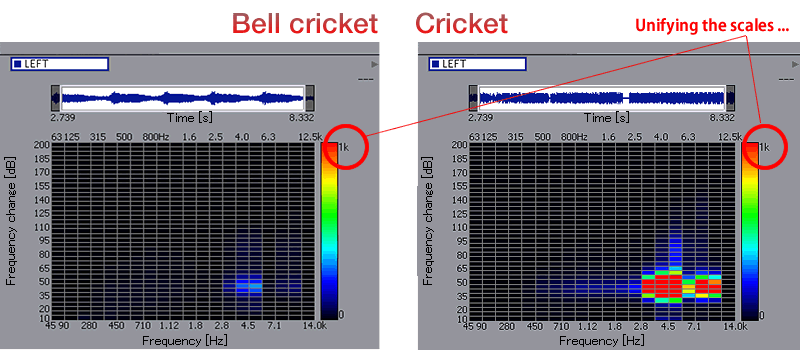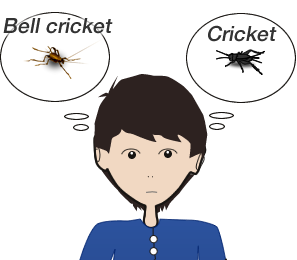- HOME
- Ono Sokki's Patio
- Insect Noise

Insect Noise
Ken: When we previously talked about which side of the brain we are using to listen to sound, you told me we were going to talk about insect sounds in detail another time.
Dad: Oh, that Japanese hear insect or nature sound with the left side of the brain, which is the language brain.
Ken: In other country, would insect sound be considered just unwanted noise?
Dad: It is true that Americans and Europeans do not feel any sense of season in the insect sounds. I've heard about a Japanese-American film before. When Japanese staff sent America a film they took in Japan, Americans complained that there was a noise and asked for a retake. But after examination, it was found that it was not a noise but were cicadas crying when they filmed outside during the summer. For Japanese, cicadas crying during the summer is a matter of course, so they feel nothing with it even if it's in the background, but for the Americans it is considered as unwanted noise.
Ken: Are there no cicadas in America?
Dad: Depends on the location but unlike in Japan, there isn't a time when they all start to cry at once. I have heard another story as well. It's awhile back, when Ueno Zoo bought an elephant from Germany, a German keeper stayed in Japan for about 2 months. When the German was about to go back, Ueno Zoo asked what he would want as a gift and he answered "I would like that crying tree".
Ken: Did he say that about the tree with the crying cicadas?
Dad: Yes. He didn't think it was the cicadas crying.
Ken: Last year I read, "The Sound of the Mountain" by Yasunari Kawabata in the classroom. In the beginning it states, "Though August had only begun, insects were already singing." The teacher said it was difficult explaining this to foreigners.
Dad: I heard about that as well. An American scholar of Japanese literature, Edward G. Seidensticker, translated it as "Though August had only begun, autumn insects were already singing." The point is that no foreigners could relate the insects crying with a season, autumn, so that they could not understand the meaning of the sentence.
Dad: There is an interesting example of an analysis of insect sounds. This is a cricket and a bell cricket crying, but listen to it. Can you tell which is which?
Insect 1 |
Insect 2 |
| Click for sound | Click for sound |
Ken: Bell cricket chirps like ring-ring. The first one sounded more beautiful so this is the bell cricket? (Insect noise 1)
Dad: Correct! It is true that the bell cricket sounds prettier. But when we analyzed these two sounds, there was an interesting conclusion. First compared on a 1/3 octave band analysis, there are barely any differences like in diagram 1.
 ■ Diagram
1 (Roll cursor over here for drawing)
■ Diagram
1 (Roll cursor over here for drawing)Ken: I thought for the pitch of sound, they were similar.
Dad: Yes. For both sounds, the 4 kHz and 5 kHz are eminent. Next, drawing a map using fluctuating sound analysis, which we used for the shamisen and Nakiryu, they are also similar like this. (Diagram 2)
 ■ Diagram
2 (Roll cursor here for a
drawing.)
■ Diagram
2 (Roll cursor here for a
drawing.)Ken: Even with fluctuating sound analysis, it can't distinguish the difference of a cricket and bell cricket, which clearly sounds different?
Dad: At first I thought it was odd too. A cricket sounds a lot more rough, so I thought it would show on a fluctuating sound analysis, just like it was able to analyze the roughness and muffled noised of the Nakiryu and "sawari" of a shamisen. But the only problem was that the scale of the axis on the map. Both changes with the same frequency/fluctuating frequency at the same time, but there is a difference in size of fluctuation. This is where the scale of axis is unified (diagram 3), and the fluctuation of a cricket is 15 times of a bell cricket.
 ■ Diagram
3 (Roll cursor over here for drawing)
■ Diagram
3 (Roll cursor over here for drawing)Ken: Is the reason the insect sound changes with time is caused by the periodical shaking of their wings?
 Dad: Insects like crickets have stridulating organs that
creates a fricative sound. There is a saw blade-like
serration on the vein of one wing and by quickly running the
other wing along the serration makes the sound.
Dad: Insects like crickets have stridulating organs that
creates a fricative sound. There is a saw blade-like
serration on the vein of one wing and by quickly running the
other wing along the serration makes the sound.
Ken: It is interesting that extracting the time-varying element, instead of sound pitch and volume, can clarify the difference in many kinds of sounds - the sounds of instrument like shamisen, sounds of insects, or the sounds created by a space, like the Nakiryu.
Dad: Yes. In case of frictional noises from a moving machine, their frequencies and the fluctuating frequencies are related to their generating mechanisms. Therefore, such information is important for creating countermeasures against unwanted noises.
Volume 65, Issue 3 (2009), pp 159-164
- © ONO SOKKI CO., LTD. 1996-2025
